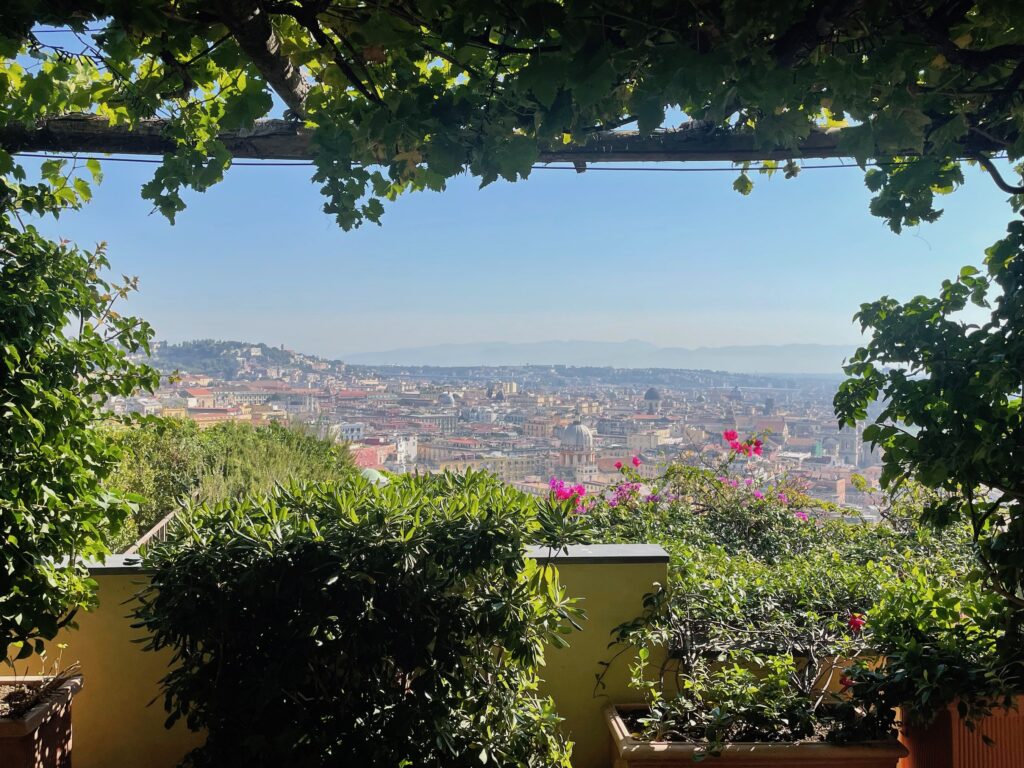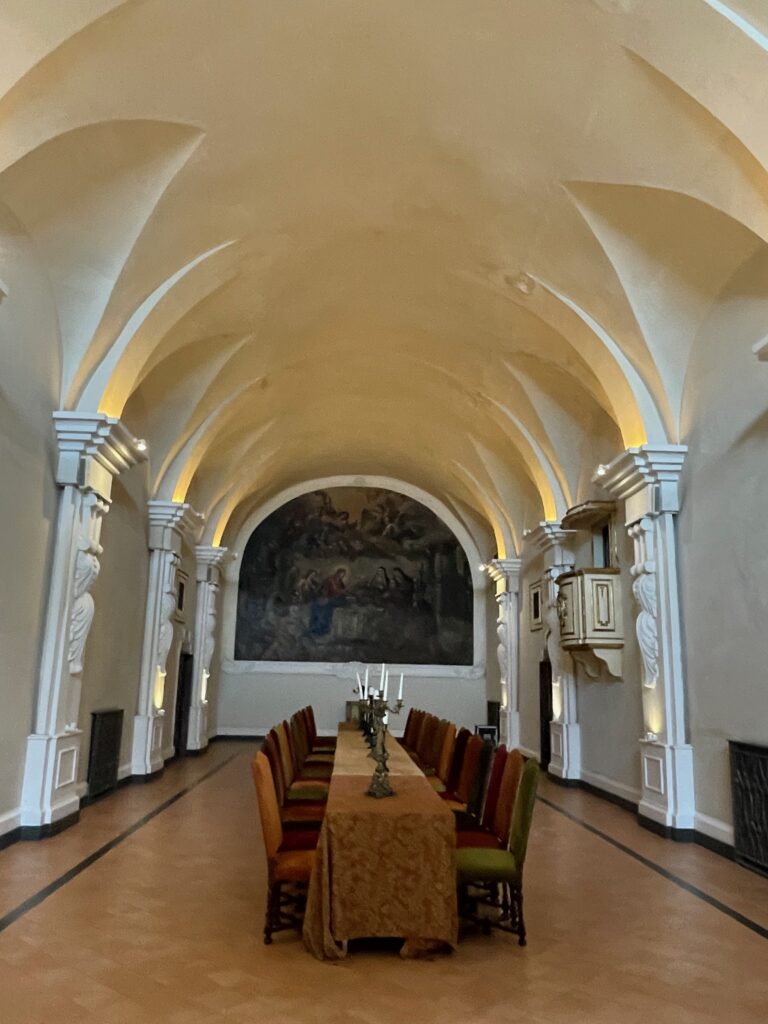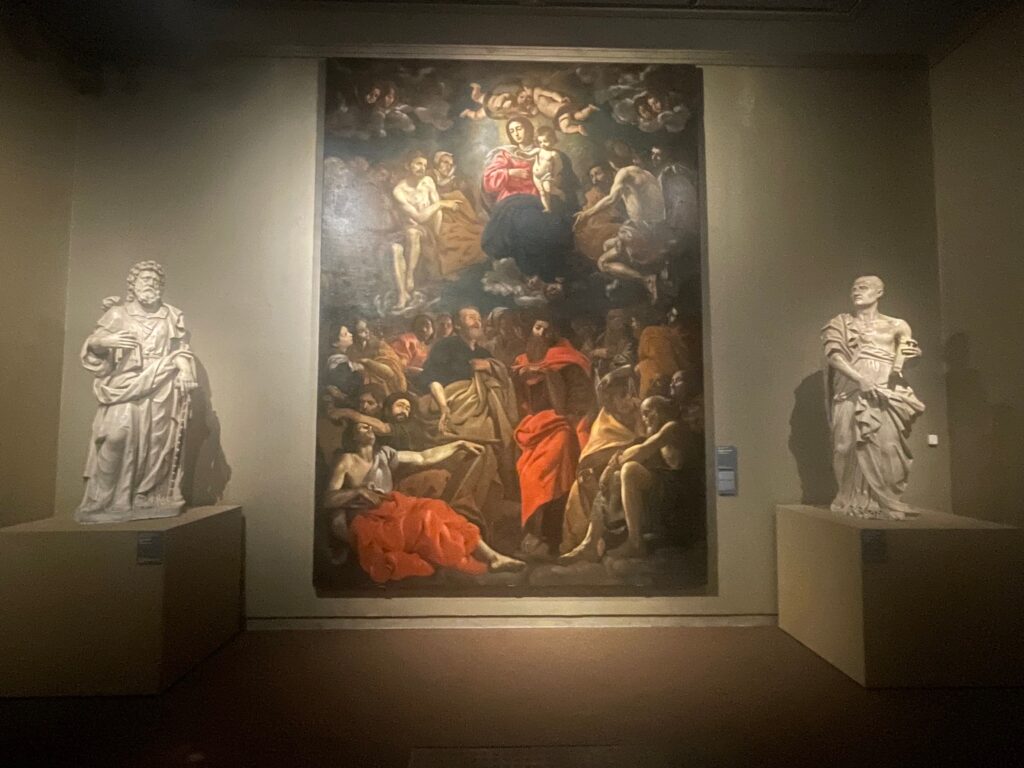Culturalee visited the ‘Beyond Caravaggio’ and ‘Battistello Caracciolo’ exhibitions at the Museo e Real Bosco di Capodimonte in Naples, and stayed at the Hotel San Francesco al Monte.
The Hotel San Francesco al Monte is a former monastery overlooking the stunning Gulf of Naples panorama. Architect Luciano Raffin oversaw an extensive project to rehabilitate and convert the left wing of the ancient monastery of Santa Lucia al Monte, which dates back to the 16th Century, when it was founded with the first single cell that Friar Augustine Miglionico of the Order of Friars Minor Conventual – also known as the “Barbanti” for their flowing beards – carved in the side of the hill of San Martino. The cell became the Church of Saint Lucia Vergine e Martire, and a more extensive and organised religious complex grew alongside it on the side of the hill.

A sensitive restoration project preserved the Chapel of San Giovan Giuseppe della Croce, patron saint of Ischia, the Hall of the Oven and the frescoed Refectory, which can all be experienced by visitors to the hotel, along with beautiful fragments of frescoes, ancient majolica and decorations dating back centuries. The third floor of the hotel houses the cell where Giovan Giuseppe della Croce spent the last 12 years of his life. Remembered for the miracle of the apricots that grew around him even during the winter, he was beatified in 1789. That same year, his cell was turned into a votive chapel and, today, it is one of the most enchanting areas of the entire hotel.
Hotel San Francesco al Monte also highlights the work of contemporary artists with a selection of artworks by the Morra Foundation including national and international artists who experimented with the most radical forms of art in the second half of the twentieth century. Among the featured artists are; Arman, Nanni Balestrini, Hermann Nitsch, Luca Maria Patella, Vettor Pisani, Paul Renner, Shozo Shimamoto and Neapolitan artists such as Renato Barisani, Carmine Di Ruggiero, Augusto Perez Gianni Pisani, Errico Ruotolo and Domenico Spinosa.

On roof of the hotel, nestled against the hill of San Martino, are a swimming pool and rooftop garden offering a 360-degree view of the city, the gulf, Vesuvius, Capri, the Vineyard of San Martino, the Carthusian monastery, and the tuff stone Castle of Sant’Elmo.
Culturalee visited the iconic Capodimonte Museum, and saw two exhibitions which are closely related: ‘Beyond Caravaggio’ (‘Oltre Caravaggio’): a new tale of painting in Naples’, which features some of the great artworks of the Neopolitan 17th Century; and a retrospective of Neopolitan artist Battistello Caracciolo (1578-1635), who was heavily influenced by Caravaggio.
‘Beyond Caravaggio’ is an extensive survey exhibition of 17th century Neopolitan artworks, featuring over 200 artworks displayed in 24 large rooms, curated by Stefano Causa and Patrizia Piscitello. The pièce de resistance of ‘Beyond Caravaggio’ is a vast canvas titled ’Flagellazione di Cristo’ (‘The Flagellation of Christ’) (1607), which Caravaggio painted for the de Franchis family chapel in the Church of San Domenico Maggiore, Naples.
Caravaggio (c. 1571–1610), born Michelangelo Merisi in Naples, was an Italian painter who is considered one of the fathers of modern painting. He is credited with inventing chiaroscuro, and his masterpieces included ‘The Death of the Virgin’ and ‘David with the Head of Goliath’. He inspired generations of artists, although his talent was often overshadowed by his controversial lifestyle.
When Caravaggio was only 6, the bubonic plague arrived in Naples, killing almost everyone in his family, including his father. The orphaned Caravaggio became an apprentice to artist Simone Peterzano in Milan, and in his late teens moved to Rome. His career and life were relatively short, and only just over 40 of his paintings still exist today. Caravaggio fled Rome after murdering Ranuccio Tomassoni during an illegal duel in 1610, dying not long after at the age of 38. In her book ‘Bright Stars: Great Artists who died too young’, Kate Bryan describes Caravaggio as ‘Art History’s Bad Boy’ and writes that ‘his motive was likely the pursuit of realism, to transform the idealized, untouchable characters that had long dominated religious painting into more relatable figures’.

This newly curated narrative of painting in Naples reconsiders the ‘Century of Caravaggio’ and features many works by Jusepe de Ribera, a Spaniard who arrived in Naples in 1616, six years after Caravaggio’s death. Also featured in the exhibition are some stunning paintings by Artemisia Gentileschi, who was the subject of a major retrospective at London’s National Gallery in 2021, including ‘Annunciazione’ (‘Annunciation’).
‘Beyond Caravaggio’ aims to revive the debate around the influence of Caravaggio by presenting a new reading of the Neopolitan ‘600, which became known as the ‘century of Caravaggio’. Art historian and critic Roberto Longhi (1890-1970) rediscovered the concept of the Neopolitan ‘600 less than a century ago. According to Longhi, Caravaggio’s naturalism was the backbone of Neapolitan art.
‘Beyond Caravaggio’ curators Stefano Causa and Patrizia Piscitello propose to reconsider Longhi’s study of Caravaggio, and to rethink the entire articulation of a century of art in Naples that not only belonged to Caravaggio, but also to Spaniard Jusepe de Ribera. This new exhibition highlights not only Caravaggio’s huge contribution to Neopolitan art and art history in general, but also shows how the artistic civilization of Naples was infused with contributions from non-Italian artists and through exchanges with other artistic centres, since Naples was a large port city and a crossroads of Italian life and culture. In the 17th century, Naples had become one of the most populous cities in the world, exerting a profound influence on European culture, and for centuries it has suffered attacks, invasions and destruction, facing numerous natural disasters: volcanic eruptions, earthquakes, tsunamis and plagues.
Several paintings by Italian Old Master Battistello Caracciolo (1578-1635) are included in the Caravaggio exhibition, while Caracciolo is the subject of a major survey show in the Sala Cause of the Capodimonte Museum, curated by Stefano Causa and Patrizia Piscitello.

Naples-born Caracciolo embodied the teachings of Caravaggio, to the point of being defined as the ‘bronze patriarch of the Caravaggeschi’ by art historian Roberto Longhi. The Caracciolo exhibition opens with a video installation and contains around 80 works by the artist loaned from Italian institutions and collections from around the world including exquisite paintings and drawings.
In the permanent collection of the Capodimonte is an extensive collection of Neopolitan art date from the 13th to 18th Centuries, and a contemporary art collection including Italian and international artists such as; Andy Warhol, Mario Merz, Carlo Alfano, Daniel Buren, Luciano Fabro, Joseph Kosuth, Mimmo Paladino, Michelangelo Pistoletto, Jannis Kounellis, Mario Merz, Louise Bourgeois, Candida Höfer and Sigmar Polke.
Culturalee’s favourite restaurant in Naples is Ristorante La Scialuppa Napoli, a buzzing restaurant situated at the Piazzetta marinari, that has been serving fresh fish and Neopolitan cuisine for 5 generations, surrounded by the sound of the waves of the port, with views of the majestic Castel dell’Ovo and lights of the Borgo.



